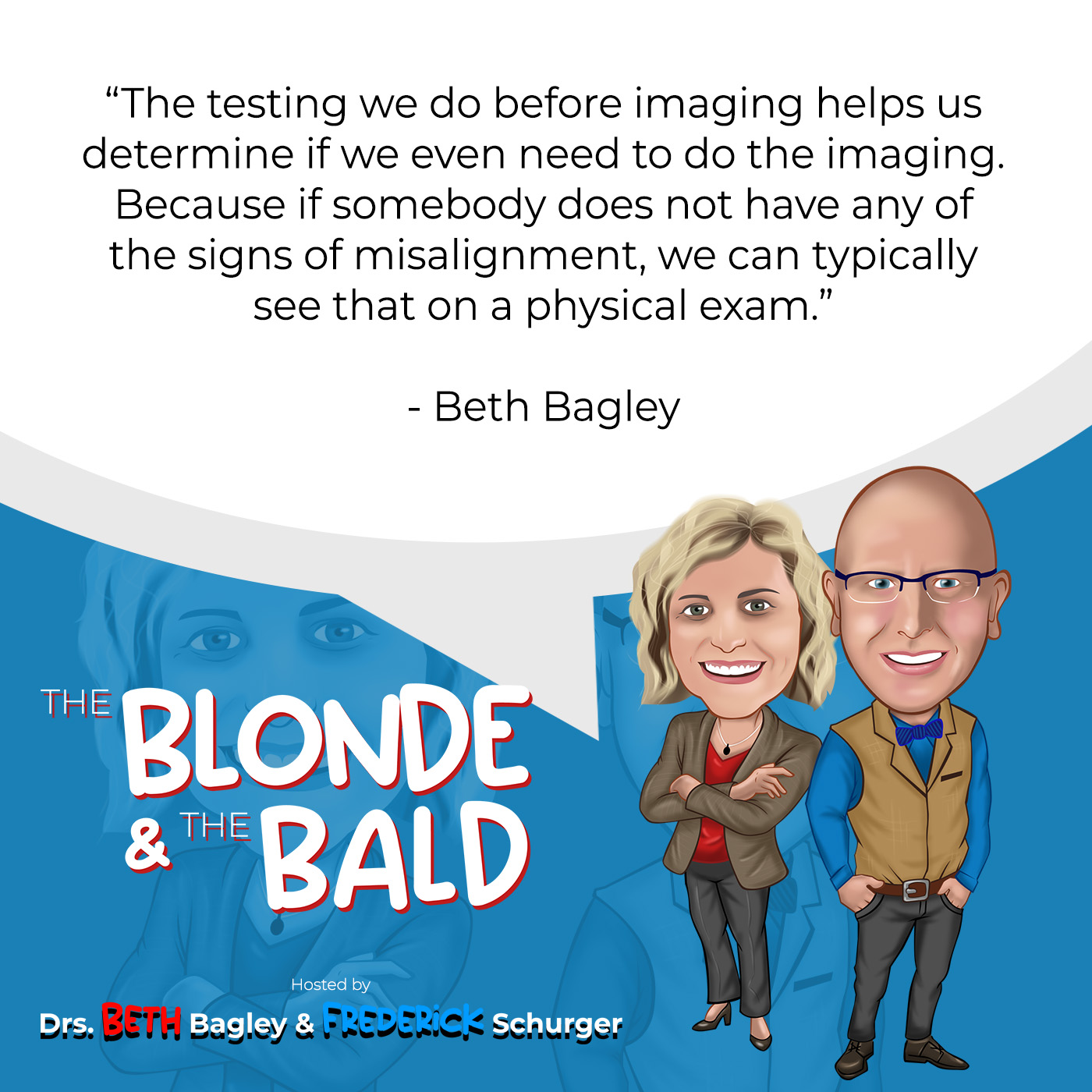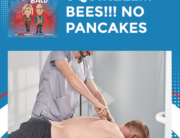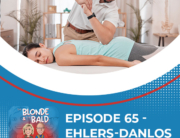
Have you ever gone to tell someone your problem only for it to fall on deaf ears? It’s a miserable situation, but it is worse when it’s your health condition, as you express it to your doctor. Too often, we hear from patients that no one can figure them out, and maybe it’s because no one has paid attention to them or asked the right questions. In this episode, Dr. Bagley and Dr. Schurger share their insights into Eagle’s Syndrome, the plight of unheard patients, and why doctors are inattentive to them. The CBCT changes that dilemma in the industry because, with the scanner, doctors can now see even the smallest misalignment in your body. Tune in to this episode now.
—
Watch the episode here
Listen to the podcast here
Eagles & The Unheard
Welcome everyone to The Blonde and The Bald. We’ve got Dr. Beth Bagley here. She’s at home.
I am at home.
I, Dr. Frederick Schurger, for those of you who are reading, I’m still sitting in my office because I was running late with a patient. There were two patients and we’ll talk about the situation of the one from a larger scale here in a little bit then I ran late with my next couple of patients and the last patient needed a new image.
It still takes time, even though it’s faster than it used to be.
It’s five minutes to do the whole thing but it’s still five minutes. When it’s five minutes at 5:45, it takes a little bit of time. We normally like to start this right at 6:00 and I’m looking at my clock now and it’s almost 6:50. This is how sometimes life goes, especially in an upper cervical practice when you have these difficult tricky cases that come on in. Let’s talk about one of them. Let me pull up this picture you sent me. Before I pull this up, I’ll hit the button in a second.
There is this discussion back and forth within the chiropractic profession, where a lot of people say, “You don’t need X-rays. It’s based on a superstition or it’s based on religion.” I’m like, “Holy cow. What got under this guy’s burr?” This was a newer paper that got published that I’m referring to. Where this guy out of Australia basically said these folks because of their founders, they’re referencing scripture and mumbo jumbo, hocus pocus. I don’t know what the heck he’s trying to have.
I don’t have a problem with referencing scripture but we have science too.
Especially when they start saying, “We don’t need X-rays to figure stuff out.” Let’s say this patient comes in and for those of you who are reading, this is a styloid process that is largely ossified. It has turned into a bone. In fact, sometimes, Dr. Bagley is putting a finger down her the side of her neck.
It’s the size of an index finger. The ear to the hyoid bone, which is in the front of your neck where your cartilage is.
If you’ve never heard of the styloid bone, it’s because generally, it’s maybe half an inch long. It’s small. It comes off of your skull just outside of your atlas area then drops down. It’s part of a muscle that comes down and joins the stylohyoid muscle, hence the name. Muscles are easy. Once you understand that muscles describe where they’re starting and ending and you understand the styloid process and the hyoid bone, it’s easy.
About 70% of them are that easy.
It’s like, “What are the origin insertions of the biceps?” I’m like, “It’s been ages since I’ve looked at that. I’m not going to be able to say it’s right in here then it’s right up here on the shoulder, especially the clavicle or the collarbone,” for those who want the layman’s term. Sometimes they’re that easy and sometimes we get a crazy picture like this one here where somebody’s entire muscle has ossified.
It’s the whole muscle. Other than that, like this little bit at the bottom. It doesn’t look like that bone is touching or it hasn’t joined with the hyoid but it’s close.
This is important because if you don’t see this thing, some of these are thin. This one is honking. As I said, index finger size. Some of these are thin and there is a concern that a atlas adjustment could break them. Let’s address that real quick. With this technology, the cone beam CT, we are seeing these things all over the place. It’s called Eagle Sign. Dr. Bagley, why don’t you explain what the Eagle sign is?
The Eagle sign is seeing an extension of the styloid process. It can lead to a syndrome, which is the Eagle syndrome. What else is the sign?
The Eagle sign is the extension of the styloid process. It can lead to eagle syndrome.
That’s the sign.
Not everybody who has this has Eagle syndrome, which I find interesting.
Where’s the crossover?
For someone like this person, I would assume that he would have the symptoms of it and maybe he has a couple. Every time I have to look it up, I’m like, “What symptoms were?” He doesn’t have these symptoms.
What are the symptoms? Why don’t we get into that? Since you looked at it more recently than I have.
Neck pain is associated with elongation of the styloid process or calcification of the styloid weight ligament clinically characterized by throat and neck pain radiating into the ear. There are other things too, which include difficulty swallowing, feeling something stuck in the throat, tinnitus or ringing in the ear and neck, or facial pain. This guy has neck pain and he feels unsteady all the time and foggy. Honestly, he has a subluxation of the atlas.
A lot of other problems too in the entire spine. If you look at this, a lot of people say, “Doc, I have the arthr.” It’s like, “Yes, you do.” This guy does. That’s got a lot of arthritis there and degeneration. If he’s an older guy, no surprise. His body has been through a lot and the question is, how long has he been out of adjustment and out of proper biomechanics? His body is breaking down because of improper biomechanics. I’ve got a great idea.
His initial injury that he never got help for was at work in the 1990s. This has been some years now.
We can see that there’s stuff that’s out of place here. Again, this is one of those that we can work around.
I will.
The cone beams have been showing this so much more. The question is, how many of these have we missed over the years to any significant level?
I don’t think that we would have missed this one on an X-ray, I’ll be honest.
Certainly not. This one should have come up bright and honking and you’re like, “Why does my atlas not show up properly?” In fact, I’d be curious to see what the X-ray view would look like in this case to get a sense of what it would have looked like otherwise. Generally, these things are small. Any concern about the smaller ones getting broken seems to be unfounded. As much as we find these on cone beam CT and we didn’t see them on X-ray, suggests to me that they were there but they’re not visible in the same manner. If they were there and we didn’t know about them and yet we were still adjusting in this area, we did not have the traumatic issues with sometimes what’s effectively the breaking of a bone.
Any concern about the smaller bones getting broken seems unfounded because as much as we find these on Cone Beam CT, we didn’t see them on X-ray.
The question is if a person like this was to get a rotary style, diversified adjustment.
Would it be a problem? I don’t know.
I don’t know the answer to that either. If you’re reading, what I’m doing is I’m turning my neck to the side and head up. Now I’ve got this finger thing and it’s not jointed so it’s just stuck. When I turn my head, it’s moving with my skull, not necessarily with my neck. A quick whip could possibly injure some structures in the neck, in my opinion.
Certainly, either it would injure or be very uncomfortable for this individual to get what we would describe as a traditional chiropractic adjustment or even manipulation from some of the PTs or DOs that do that work. Again, it’s good to know what you’re working with. This is the importance of an X-ray in these cases. In any case, I had a great idea but I think we’re going to have to save it for another time because it’s sitting in the back of the office. I don’t want to run back there and grab it now. Is anything else you see on this that’s of interest?
He’s got severe osteoarthritis in the facet joints and I honestly haven’t gone through much of it yet because he just came in. I’m excited to work with him though. He’s a sweet guy. You’re going to like him.
I think he’s going to do great once you get his head on straight. What’s interesting is as you see in the lower part of this, this is all osteoarthritis. These are the facet joints back here. These are the intervertebral foramina where the nerves and a couple of arteries and veins come out at each level and then these are the vertebral bodies here in the front. There’s lots of degeneration. We can’t see it here because of the angle that you took this at for the atlas. We do not see that at the atlas, which is always a curious factor. Did we talk about Dr. Blair’s proving of his theory in the war museum?
I think we hit on it but I wish I was at work because I have the book that he wrote. It’s a little booklet.
Maybe we’ll retouch on that next episode, so let’s make a note of that.
If somebody wants to tune in next episode, it’ll be one of the research things that Dr. Blair did. It’s looking at a body in a museum. It’s interesting, so we’ll go over that next episode.
We’ll explain more about it. There was a lot of arthritis except at the atlas. The atlas was the last joint for that man to fuse. There is a natural situation where the atlas does not get very arthritic. Our body protects it in one shape or form or another before that one breaks down even though it’s out of place. Wrap your head around that one. That’s getting back to the biblical verses. There’s good knowledge there. As one of my patients and I like to describe, “We are fearfully and wonderfully made.” We understood anything that’s going on there. That was the point I wanted to point out there.
We don’t see a lot of arthritis at C1 and the occiput at the cranial cervical junction. Below it, we see a ton of arthritis.
You can see it all the way through up and down. Depending upon the patient, some are older patients like this. I’ve seen patients who have no arthritis. I’ve got a 25-year-old and a 26-year-old young lady come in and her neck is a complete mess. She had a ton of arthritis and I think I’ve mentioned her in the past. She was told she’d be unable to have children because of everything she was going through. We got her adjusted and within about a year, she got pregnant and had a beautiful baby girl.
We’re getting old, Fred.
We are getting old because that’s the only direction. It flows. We keep on looking like we’re younger because we keep ourselves in good health.
We’re good at adjustments. You were telling me about what you called the unheard patient.
This is the case that I had right before my 5:00 patients came in that ran me behind. This young lady had been a patient before. Quite honestly, we’d had a little bit of these pieces put together at that point in time. I’ve learned a ton over the years. As I was looking at her MRIs, I don’t know if she had brought them in at the time.
Because of her circumstances even then, she only came in one day. She was from out of town. I’m like, “We’re going to work with you,” then she never came back but her health has happened to deteriorate and nobody can figure out what’s going on with her. There are a lot of things at play. I have several of these cases. These people who are otherwise, their brains are working the way they’re supposed to but yet they are not feeling great and the doctors they go to.
St. Louis might be a little bit better because you’ve got the large metropolitan area. Here in the Midwest or in the Central Illinois area, we’ve got some great doctors but they’re few and far between. Finding the right doctor who can start to put together all the pieces is becoming more problematic and these patients simply become unheard because they go in for their visit with their medical doctor. You have seven minutes to figure out which pill I need to give you.
She’s got multiple problems. They’re suggesting EDS at the very least. She’s got some torn ligaments that she doesn’t know how she ever got into this pinch as it were because she doesn’t have any car accidents sitting around that say, “It was this car accident. It was that car accident. I played sports in high school.”
It could be any of a number of things but she does remember somehow she was grabbed by the head. Either case, whatever it was. She’s in a pinch and her health is deteriorating. I see so many of these. I’ve got another patient. He was a military vet Marine. I’ve got to sit down with him and we’ll have a long talk on the show here in the future.
He was honorably discharged for health issues after a car accident. They couldn’t figure out what was going on. He’s like, “Doc, once we get the head on straight, now all those symptoms start to dissipate. If it’s between visits or on the weekend and I know I can’t get in touch with you to get checked, all I have to do is apply a little bit of pressure and lay back and all of a sudden, I get some of that relief.”
He’s been identifying this for a while but yet his doctors are not looking at the upper cervical work that we do here. Oftentimes, they dismiss it. His anecdotal experience as being, “You’re just making it up. Let’s get you to the psychologist or psychiatrist and get you on some meds to help you on your way.” You feel so bad for these people because they don’t have answers.
The desperation sometimes turns. For a doctor who also doesn’t have the answers, these patients turn into an annoyance and then get treated not like people anymore but as an annoyance or they’re crazy. That’s what gets me. It hurts me because people will come to us in desperation. Some people come to us before they’re at that point. I love that but for many people, we’re the last resort and they’re going to go to this crazy chiropractor who does this weird thing to their neck because their aunts, sisters, or friend said they should go.
They come to us and they tell this story. To us, our brain goes, “Nobody’s checked the neck.” That’s where all of the nerves go through. Why has no one checked the neck? The doctors just didn’t know. It’s not like they’re trying to be mean and disrespectful to these people if they want the best for their patients. At least most of them do. A show like what we’re doing, what we try to do is we’re getting the word out because there are people desperate.
If you read this and you’re like, “This sounds just like me or my daughter,” or if you’re a doctor and you’re like, “This sounds like four of my patients and I have no idea what to do with them because we’ve tried everything,” we need to check the neck. If there’s not something going on, we can usually tell that before we even do imaging because the testing we do before the imaging helps us determine if we even need to do the imaging. If somebody does not have any of the signs of misalignment, we can typically see that on a physical exam.

I am confident. I’ve had two cases in my years of practice where they came in and I’m like, “Let’s do an exam and see what’s going on.” The one was a young lady. She rides horses now and I think she’s planning on training horses, which means I haven’t seen her for several years. However, for the first time, I checked her mom and her sisters were in regularly. She was holding them like, “We don’t have to do anything until she falls off that horse.”
The other one was in her late 40s or early 50s young lady that was having some problems with vertigo but not vertigo and some dizziness. There are eyes, ears, then there’s the upper neck that all can lead into vertigo. Sure enough, she checked clear of everything that I checked it twice. I’m like, “If your neck gets screwy and you’re in a car accident, come see me. I will take care of you at that point in time.
I can’t help you if there’s nothing for me to do.” I sent her off to an optometrist who does a lot of balancing with the eyes. I think she got better. It’s just a matter of finding the right doctor for the patients. Sometimes, the other half of it is you got to say, “We got to start somewhere. We got to work you through things. This is not going to be an easy path.” Recognize that sometimes the pain and the experiences and healing do not always feel good.
You and I have been talking about doing a detox. This one that I’m on is very gentle so far. I’m going to get a little bit crass here. I hope you’re not eating at home. I’ve heard that through the parasite cleansing that this thing does, people will have parasites come out. It’s not just coming out of number two. It can be coming out of your nose, eye, or gums. I don’t want it.
At the same time, I don’t want those in me. If they’re going to come out, please come out but I also will have nightmares over that. Thank you for that.
You’re welcome. I’ve got an Australian joke that I need to send you. Did I send you that one about the cute little guy? Let me go get this other picture. That was funny so that everyone can appreciate the funny.
Have you heard of a product TRT? It is a zeolite. Anyway, it’s supposed to absorb heavy metals in the body.
I have not. That does not ring a bell.
It’s TRS detox and it’s a zeolite suspension.
I’m not familiar with that but so many of those things, they’re like a tea.
It’s one of those things that costs a lot of money and it could just be water. I follow some of those in Facebook. I do take a lot from what people say because again, we hear so many of these stories of, “I did this and this happened.” It’s the same thing over and over again. There has to be something to it. For this product, there have been changes in autism symptoms and things like that. It’s usually moms and I’m not going to say it’s dads sometimes that are giving it to their kids. Also, adults are putting that out there. If somebody does a little research on TRS, that could be another way to look at to explore detoxing from heavy metals.
Back to the point of the healing process. The healing process doesn’t always involve feeling good.
That’s what my point was. Many people will talk about it in that Facebook group. When they start taking the spray, they dip. They can release some parasites too but they will have symptoms. Sometimes, they’re pretty nasty symptoms as they’re going through it. It sucks but it’s cool.
Here’s the funny.
“Not all Australian animals will kill you. Don’t get me wrong. He wants to, he just can’t.” That’s cute. What is that?
I don’t know but for those of you reading, it is some cute little mouse jaguar-looking thing but it’s the size of a mouse sitting on the thumb.
That has to be photoshopped. Otherwise, I want one.
It looks adorable. It’s one of those funny things. For these people who are these unheard patients and I feel like I’m seeing a lot of them. They’ve been in and they do great.
They do. It’s unbelievable. Also, when you find a doctor, we care about you, want the best for you, and we’ll tell you if this isn’t going to work. If we don’t think you’re a candidate for care, we don’t want to waste your time or waste our time or waste money. Honestly, we’re not in it for the money. We need money and keep our lights on but that’s not why we do this.
The truth is chiropractors in general tend to be listeners. We have a caring heart. If you are suffering and need someone to take the time to listen to your story and put it together, we also have science brains. We care and we have science brains, which don’t always go together. I was talking about neurosurgeons and I was like, “If I was having neurosurgery, I don’t need you to be warm and fluffy with me.”
In fact, I don’t want them to be warm and fluffy.
I don’t want it. I would rather you be Kirk, to the point, and be good.
We need Spock. I want Mr. Spock. I don’t want Captain Kirk.
Mr. Spock would be able to fix it with his fingers.
For those of you who are reading and feel that you’re one of these unheard patients, also realize that we are not going to spend three hours with you listening to you moan and groan.
It’s not about complaining.
We are going to listen to you and figure out, “What can we do and what are plans of action?” We don’t have to do the plan of action but we do need to identify that there is a plan of action that can be taken because sometimes, the best point of action is we got through half of the exam and we took a picture. “You are exhausted. I have a waiting room full of patients tomorrow. We’re going to do some more time tomorrow because this takes a lot out of us too.”
We joke about our three days of office time then the rest of it seems off. Some of that is decompressing to deal with our own lives and everything else that’s going on around us but we’re going to sit down and talk to you. We’re going to spend more than seven minutes. We’re going to do an exam and take pictures if we do find that we need to.
We probably will then we’ll go over those pictures later.
More importantly, we’re going to review those pictures.
We’ll review them and then show you them. Many patients will say, “Did they show you the MRI? Did they show you your X-rays or your CT scan?” I almost never hear anyone getting to see their pictures. They get a report that goes under their portal.
This patient had the same thing and she’s like, “No one has looked at this.” Granted, have I had 100 extra hours of MRI training? I have. That’s part of my stuff and you haven’t. The reason you don’t want that is because you’re going to pick my brain and there’s nothing wrong with that.
I do that.
You do but the point being is we’ve got to figure out what is best for every individual as opposed to being a cog in the machine because we are not cogs in the machine.
We must figure out what is best for individuals compared to being a cog in the machine because we are not cogs.
No, I don’t want to be. I don’t want that.
It’s ugly. The Mandalorian, for those who are not paying attention, episode 3 of season 3 was out. For those of you who are watching The Mandalorian when this comes out, you’ll know what I mean about the weird cog in the machine episode. Have you watched it yet?
The last one we watched ended when he went underwater. I’ve not watched the new one?
You’ll understand that once you watch it. You’ll be like, “This is interesting,” anyways.
I don’t think medical doctors want to be that either but they are stuck in a paradigm now. That’s not their fault and there are some that have escaped it.
It’s a little bit of their fault.
It’s not the current generation’s fault.
When you are in a system and I’m going to say it is, only because they’re playing by the rules as opposed to trying to step out of the game. We stepped out of the game right off the bat by going into chiropractic and said, “Something is wrong with that paradigm.” COVID made that obvious because as I’m listening to Dr. Peter McCullough’s podcast, he was talking with his new partner who basically said, “I’m going to do some research and figure out what takes care of Coronaviruses,” and looked at, “Here’s a paper written by Anthony Fauci that says chloroquine is good for getting zinc ionifers into the cell.” Anyways, this guy was already outside of the system and his patients during early COVID did well. It’s a matter of having doctors that are paying attention and doing their due diligence.
When people get frustrated, they’re like, “Any of the doctors that helped me don’t take insurance.” I hear that and I’m one of them. I don’t directly take insurance. I give you a super bill, which is a bill that allows you to just turn it into your insurance. At that point, some people get paid and other people don’t. I don’t take the time to play that game because that game then puts us as a cog. We’re back into the cog and we have to obey their rules and follow their recommendations. It’s like, “You only get six visits and that’s not covered but this is, so do it this way.” I’m like, “We’re not going to play that game because that does not help our patients.”
Dr. McCullough is coming out of the insurance game to work with this group. They are not quite concierge. It’s a slightly different form of that. The funny thing is they started figuring out the dollars with the co-pays and everything else. Most patients are paying a little bit less than they would if they would have gone into the system and met their deductible. It’s still less than your deductible. For some people, everything works just fine. This was me when I first got introduced to chiropractic. It’s like, “This stuff isn’t too bad,” but it’s also the same situation where sometimes it’s not a one size fits all. If you find yourself in the non-one-size-fits-all place, you need to look outside the system.

Yes, and that’s okay. Some people might be like, “That sounds crazy.” They’re not living your life. They’re not inside your body. You know what you feel like and what’s true. There’s mental illness out there. I do know that but many people are being called crazy or that they need to be on psychiatric medications because they don’t have an answer and no one’s checked the neck. You got to check the neck. You got to do it.
I think that’s a great place for us to wrap up and we will be back with another episode of The Blonde and the Bald.
I’m Dr. Beth Bagley. I’m in St. Louis, Missouri. You can find me at www.PrecisionChiropracticSTL.com.
I’m Dr. Frederick Schurger in Springfield, Illinois, KeystoneChiroSPI.com. We look forward to you tuning in to the next episode. Send us comments and everything should be going live very soon.
Please share.
It should be closer to getting questions answered and we’ll be more than happy to share any questions that you have.
If you post questions and it’s something that we want to bring up in the show, we will gladly bring it up and talk it over. Have a good one, everyone.
Important Links





